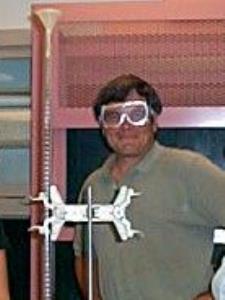I'm assuming that these are aqueous solutions of each reactant. Both of them are soluble, but when you combine the reactants, you'll get a precipitate of insoluble barium sulfate, which can be filtered out from the remaining solution, then dried and weighed. The answer you can calculate is the theoretical yield of barium sulfate. Under experimental conditions, it's likely that the yield will be slightly different (higher or lower), but it's worth calculating the theoretical yield, so you know how much to expect, under ideal conditions.
First, it helps to write the reaction and make sure it's balanced:
Ba(NO3)2 (aq) + Na2SO4 (aq) → BaSO4 (s) + 2 NaNO3 (aq)
It's easy to check the balancing in this reaction: on each side, we have one Ba2+ ion, two NO3– ions, two Na+ ions, and one SO42– ion.
The fact that you have some of each reactant makes this what they call a "limiting reactant problem." The basic idea is that you need to calculate which reactant gets used up first, because once that happens, you can't make any more of the product. The most "foolproof" way I know to figure out which reactant is limiting is to calculate how much of one of the products you'll get if each reactant were to react completely. You basically need to do both calculations, then compare the answers. The limiting reactant (i.e., the one that gets used up first) will be the reactant that produces the least amount of product.
To set up the calculations, it's useful to have a plan. As in most stoichiometry problems, the idea is to use the mole ratios from the balanced chemical equation to find out how much product can be formed from a given amount of reactant. Because this is a limiting reactant problem, we'll have two paths for our calculations.
(Path 1) to calculate the amount of BaSO4 that could be produced from 60.0 grams of Ba(NO3)2:
grams Ba(NO3)2 → moles Ba(NO3)2 → moles BaSO4
(Path 2) to calculate the amount of barium sulfate that could be produced from 2.0 grams of sodium sulfate:
grams Na2SO4 → moles Na2SO4 → moles BaSO4
Once we get both answers, we'll use the smaller amount and convert it: "moles BaSO4 → grams BaSO4". We're using the smaller amount because there won't be enough of the limiting reactant to produce the larger amount.
To do the "gram → mole" conversions, we'll need some molar masses:
- Molar mass of Ba(NO3)2: (1 x 137.3) + (2 x 14.01) + (6 x 16.00) = 261.32 g/mol
- Molar mass of Na2SO4: (2 x 22.99) + (1 x 32.07) + (4 x 16.00) = 142.05 g/mol
- Molar mass of BaSO4: (1 x 137.3) + (1 x 32.07) + (4 x 16.00) = 233.37 g/mol
Now we can use the paths shown above to help put the calculations together:
Path 1:
60.0 g Ba(NO3)2 x (1 mol Ba(NO3)2 / 261.32 g Ba(NO3)2) x (1 mol BaSO4 / 1 mol Ba(NO3)2) = 0.230 mol BaSO4
Path 2:
2.0 g Na2SO4 x (1 mol Na2SO4 / 142.05 g Na2SO4) x (1 mol BaSO4 / 1 mol Na2SO4) = 0.0141 mol BaSO4
The smaller answer (0.0141 moles BaSO4) is the correct answer for the amount of product that can be formed. There is only enough sodium sulfate to make this amount; no more barium sulfate can be formed, because there isn't any sulfate left! Moles aren't very useful as units, though, so the problem is asking for grams.
0.0141 mol BaSO4 x (233.37 g BaSO4 / 1 mol BaSO4) = 3.3 g BaSO4
You can only report two sig figs, because the mass of sodium sulfate has been measured to only the tenths place; 2.0 is only two sig figs.
There will be some leftover barium nitrate in the solution. The concentration of each remaining ion (Ba2+, Na+, and NO3– in solution could be calculated, but that's another problem. To go even further, we could calculate the amount of sulfate left in solution (even though it's going to be only a tiny quantity), but that is another problem as well.
I hope this is helpful.







